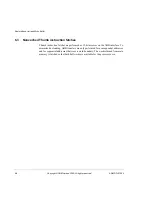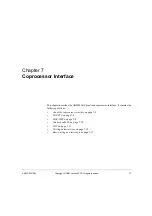
Bus Interface Unit and Write Buffer
Copyright © ARM Limited 2000. All rights reserved.
6-9
6.4
AHB clocking
The ARM946E-S design uses a single rising-edge clock CLK to time all internal
activity. In many systems in which the ARM946E-S is embedded, you might prefer to
run the AHB at a lower rate. To support this requirement, the ARM946E-S requires a
clock enable, HCLKEN, to time AHB transfers.
The HCLKEN input is driven HIGH around a rising edge of the ARM946E-S CLK to
indicate that this rising-edge is also a rising-edge of HCLK. HCLK must be
synchronous to the ARM946E-S CLK.
When the ARM9E-S is running from tightly-coupled SRAM or performing writes using
the write buffer, the ARM946E-S HCLKEN and HREADY inputs are not used to
generate the SYSCLKEN core stall signal. The core is only stalled by SRAM stall
cycles or if the write buffer overflows. This means that the ARM9E-S is executing
instructions at the faster CLK rate and is effectively decoupled from the HCLK domain
AHB system.
If, however, you want to perform an AHB read access or unbuffered write, the core is
stalled until the AHB transfer has completed. As the AHB system is being clocked by
the lower rate HCLK, HCLKEN is examined to detect when to drive out the AHB
address and control to start an AHB transfer. HCLKEN is then required to detect the
following rising edges of HCLK so that the BIU knows the access has completed.
If the slave being accessed at the HCLK rate has a multi-cycle response, the HREADY
input to the ARM946E-S is driven LOW until the data is ready to be returned. The BIU
must therefore perform a logical AND on the HREADY response with HCLKEN to
detect that the AHB transfer has completed. When this is the case, the ARM9E-S core
is enabled by reasserting SYSCLKEN.
Note
When an AHB access is required, the core is stalled until the next HCLKEN pulse is
received, before it can start the access, and then until the access has completed. This
stall before the start of the access is a synchronization penalty and the worst case can be
expressed in CLK cycles as the HCLK to CLK ratio minus 1.
6.4.1
CLK to HCLK skew
The ARM946E-S drives out the AHB address on the rising edge of CLK when the
HCLKEN input is TRUE. The AHB outputs therefore have output hold and delay
values relative to CLK. However, these outputs are used in the AHB system where
transfers are timed using HCLK. Similarly, inputs to the ARM946E-S are timed
Содержание ARM946E-S
Страница 1: ...ARM DDI 0155A ARM946E S Technical Reference Manual ...
Страница 6: ...vi Copyright ARM Limited 2000 All rights reserved ARM DDI 0155A 04 Limited Confidential ...
Страница 54: ...Programmer s Model 2 34 Copyright ARM Limited 2000 All rights reserved ARM DDI 0155A ...
Страница 70: ...Caches 3 16 Copyright ARM Limited 2000 All rights reserved ARM DDI 0155A ...
Страница 78: ...Protection Unit 4 8 Copyright ARM Limited 2000 All rights reserved ARM DDI 0155A ...
Страница 98: ...Bus Interface Unit and Write Buffer 6 14 Copyright ARM Limited 2000 All rights reserved ARM DDI 0155A ...
Страница 112: ...Coprocessor Interface 7 14 Copyright ARM Limited 2000 All rights reserved ARM DDI 0155A ...
















































